Abstract
Sera from sequentially bled nephropathia epidemica patients (acute-phase, convalescent-phase, and 2-year sera) and sera from 10 to 20 years postinfection were examined by immunoglobulin G (IgG) subclass-specific ELISAs for reactivities against each of the Puumala virus structural proteins (N, G1, and G2). IgG1 was found to be the dominating antiviral subclass, and most of the patients had IgG1 directed to all three structural proteins at all times with a continuous increase over time. IgG2 to the three viral proteins was detected in very low amounts in only a few of the samples. All of the serially bled patients developed IgG3 against each of the proteins, but the responses against the different viral components varied; anti-N- and anti-G1-specific IgG3 showed a peak in the convalescent-phase samples, while the anti-G2 IgG3 response was highest in the acute-phase sera. Eight of ten serially bled patients developed specific IgG4. The IgG4 responses showed similar patterns against all three viral proteins with very low optical density values in the acute- and convalescent-phase samples, followed by higher optical densities in the sera drawn 2 years after infection. Seven of nine 10-year sera contained virus-specific IgG4. These results support the theory concerning the persistence of Puumala virus or viral antigens several years after infection.
Full text
PDF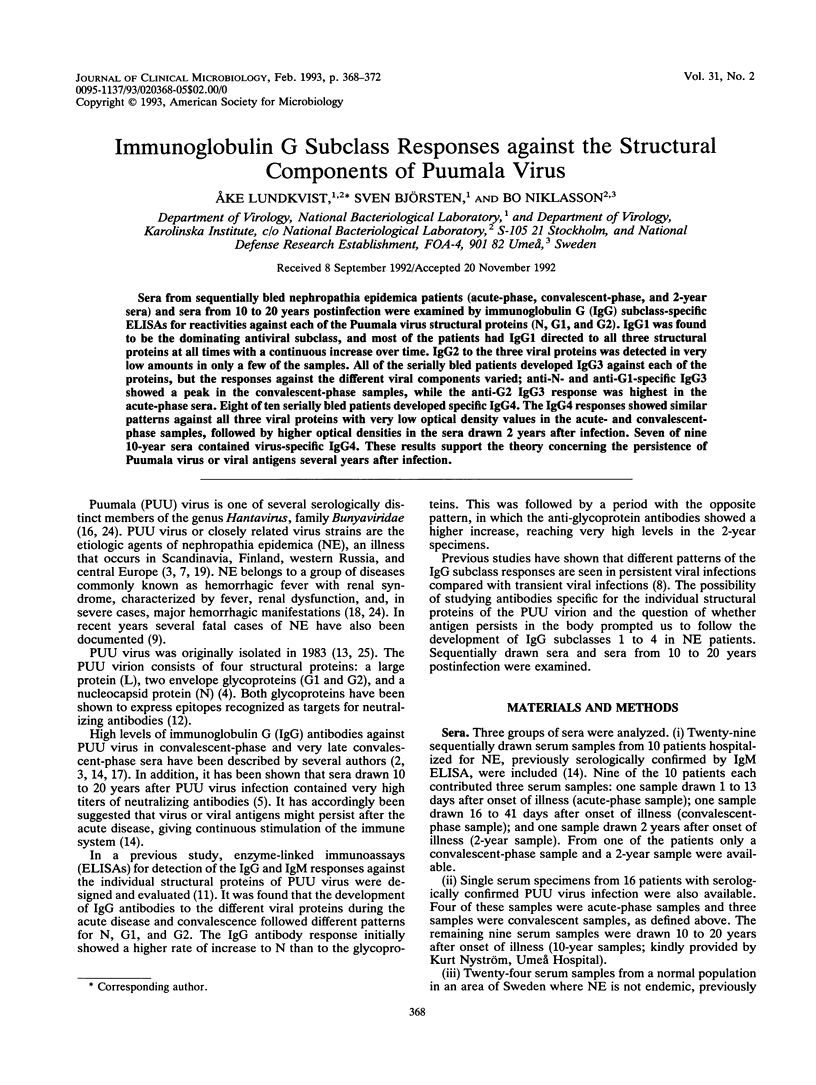
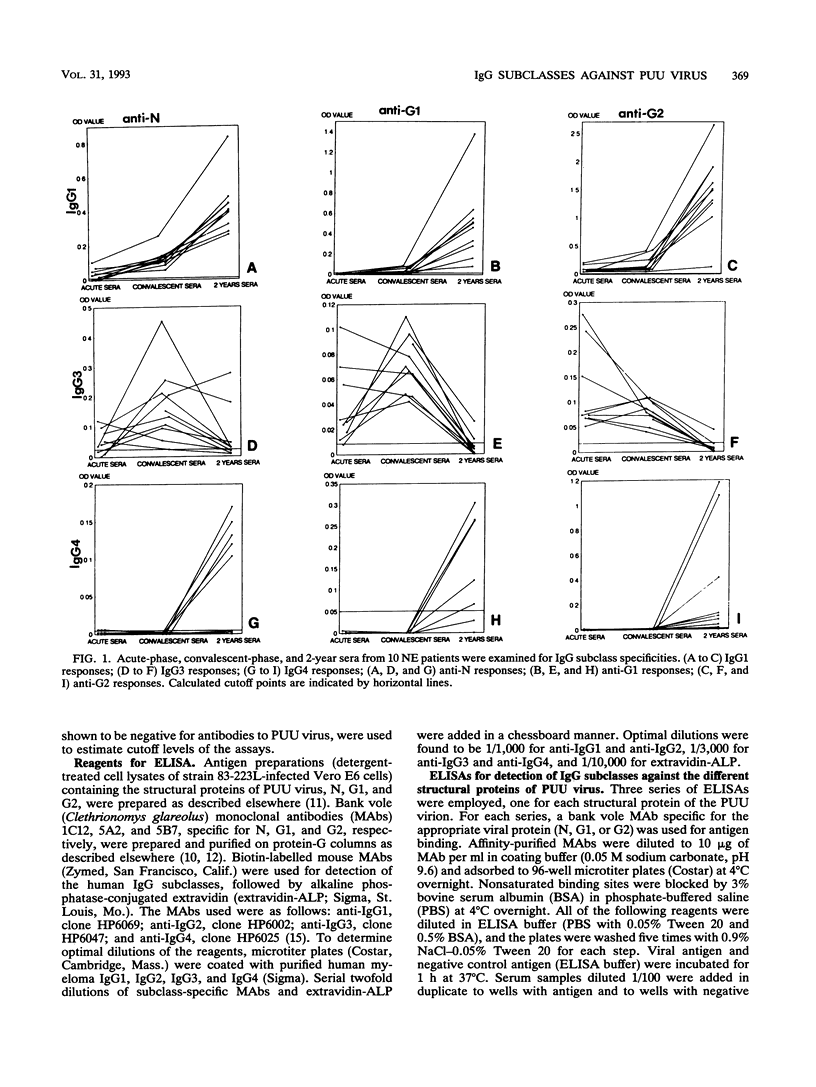
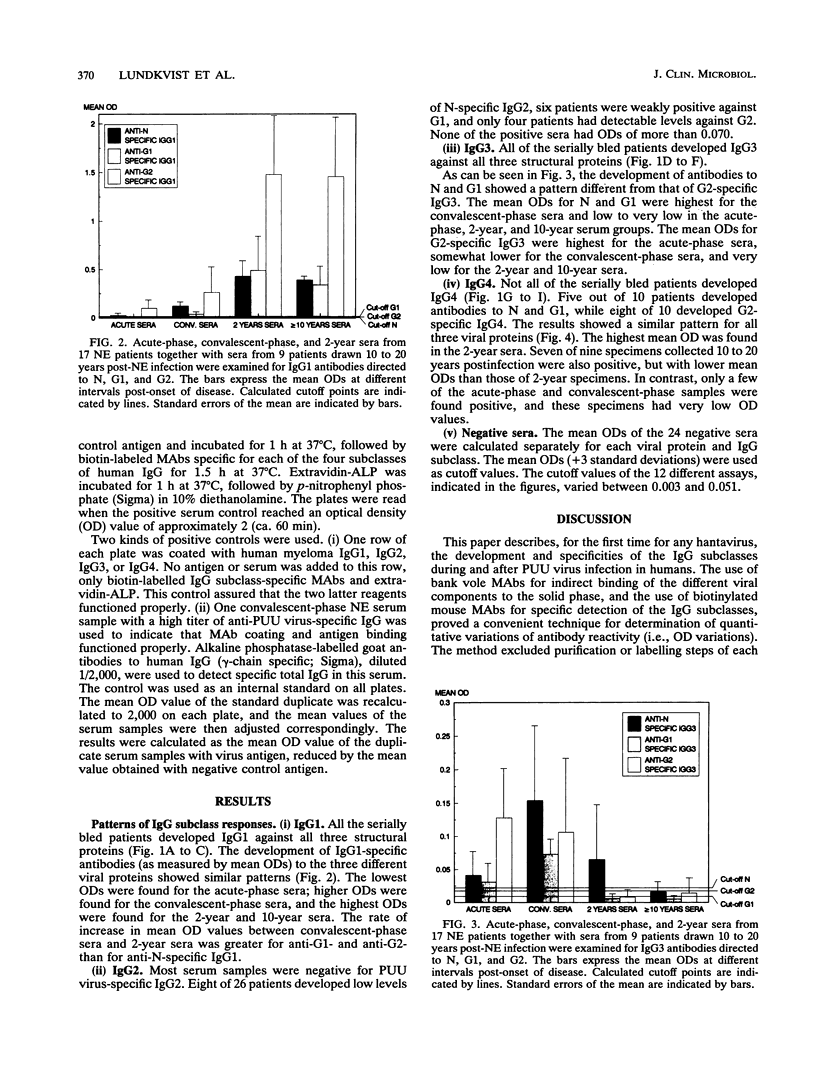
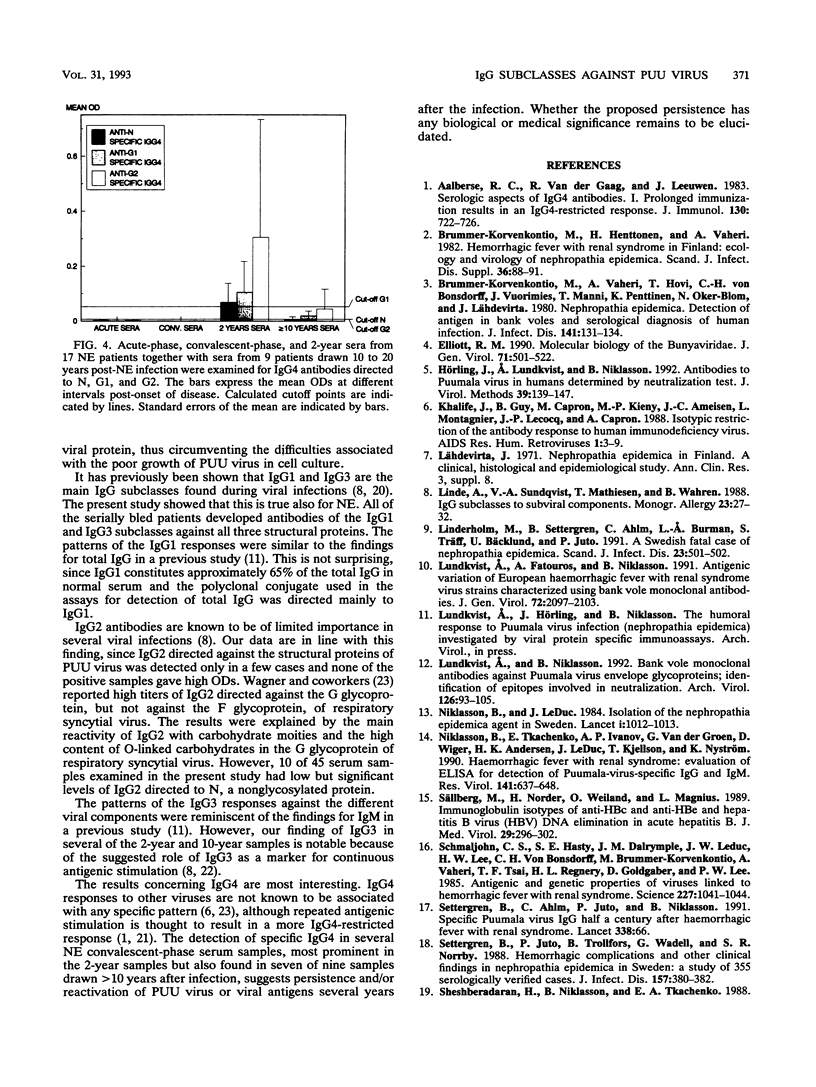
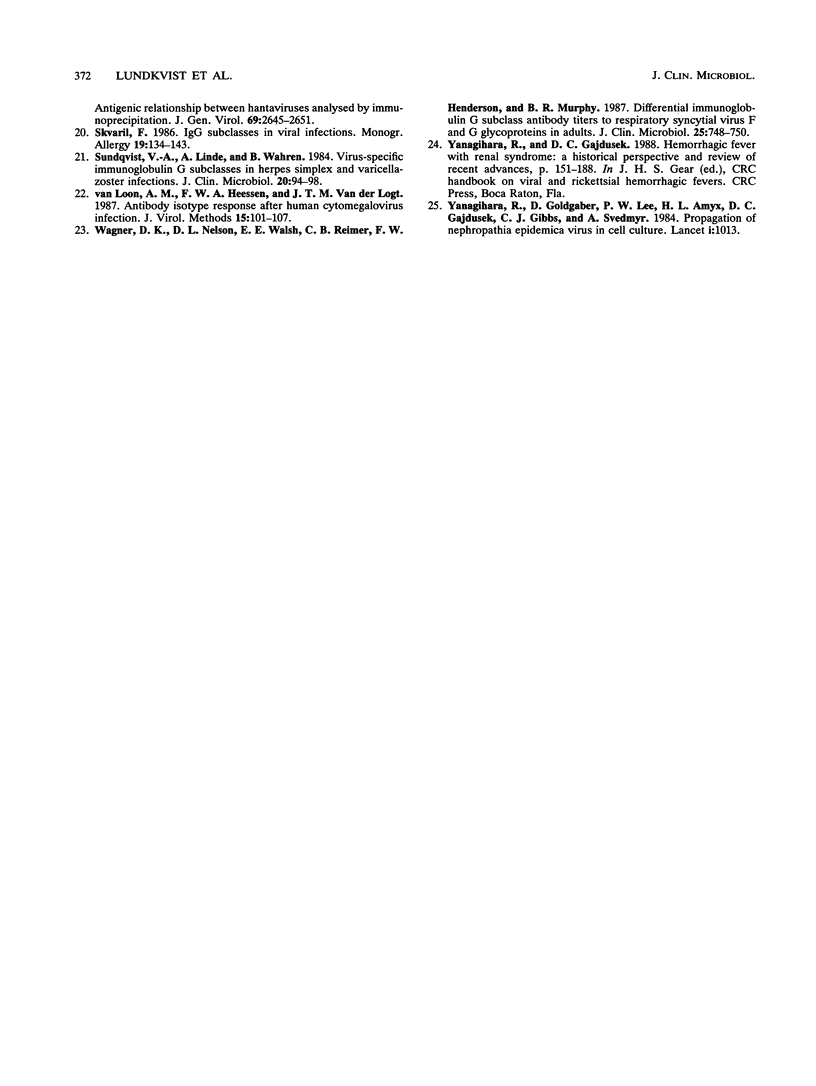
Selected References
These references are in PubMed. This may not be the complete list of references from this article.
- Aalberse R. C., van der Gaag R., van Leeuwen J. Serologic aspects of IgG4 antibodies. I. Prolonged immunization results in an IgG4-restricted response. J Immunol. 1983 Feb;130(2):722–726. [PubMed] [Google Scholar]
- Brummer-Korvenkontio M., Henttonen H., Vaheri A. Hemorrhagic fever with renal syndrome in Finland: ecology and virology of nephropathia epidemica. Scand J Infect Dis Suppl. 1982;36:88–91. [PubMed] [Google Scholar]
- Brummer-Korvenkontio M., Vaheri A., Hovi T., von Bonsdorff C. H., Vuorimies J., Manni T., Penttinen K., Oker-Blom N., Lähdevirta J. Nephropathia epidemica: detection of antigen in bank voles and serologic diagnosis of human infection. J Infect Dis. 1980 Feb;141(2):131–134. doi: 10.1093/infdis/141.2.131. [DOI] [PubMed] [Google Scholar]
- Elliott R. M. Molecular biology of the Bunyaviridae. J Gen Virol. 1990 Mar;71(Pt 3):501–522. doi: 10.1099/0022-1317-71-3-501. [DOI] [PubMed] [Google Scholar]
- Hörling J., Lundkvist A., Huggins J. W., Niklasson B. Antibodies to Puumala virus in humans determined by neutralization test. J Virol Methods. 1992 Sep;39(1-2):139–147. doi: 10.1016/0166-0934(92)90132-w. [DOI] [PubMed] [Google Scholar]
- Khalife J., Guy B., Capron M., Kieny M. P., Ameisen J. C., Montagnier L., Lecocq J. P., Capron A. Isotypic restriction of the antibody response to human immunodeficiency virus. AIDS Res Hum Retroviruses. 1988 Feb;4(1):3–9. doi: 10.1089/aid.1988.4.3. [DOI] [PubMed] [Google Scholar]
- Linde A., Sundqvist V. A., Mathiesen T., Wahren B. IgG subclasses to subviral components. Monogr Allergy. 1988;23:27–32. [PubMed] [Google Scholar]
- Linderholm M., Settergren B., Ahlm C., Burman L. A., Träff S., Bäcklund U., Juto P. A Swedish fatal case of nephropathia epidemica. Scand J Infect Dis. 1991;23(4):501–502. doi: 10.3109/00365549109075100. [DOI] [PubMed] [Google Scholar]
- Lundkvist A., Fatouros A., Niklasson B. Antigenic variation of European haemorrhagic fever with renal syndrome virus strains characterized using bank vole monoclonal antibodies. J Gen Virol. 1991 Sep;72(Pt 9):2097–2103. doi: 10.1099/0022-1317-72-9-2097. [DOI] [PubMed] [Google Scholar]
- Lundkvist A., Niklasson B. Bank vole monoclonal antibodies against Puumala virus envelope glycoproteins: identification of epitopes involved in neutralization. Arch Virol. 1992;126(1-4):93–105. doi: 10.1007/BF01309687. [DOI] [PubMed] [Google Scholar]
- Niklasson B., Le Duc J. Isolation of the nephropathia epidemica agent in Sweden. Lancet. 1984 May 5;1(8384):1012–1013. doi: 10.1016/s0140-6736(84)92344-4. [DOI] [PubMed] [Google Scholar]
- Niklasson B., Tkachenko E., Ivanov A. P., van der Groen G., Wiger D., Andersen H. K., LeDuc J., Kjelsson T., Nyström K. Haemorrhagic fever with renal syndrome: evaluation of ELISA for detection of Puumala-virus-specific IgG and IgM. Res Virol. 1990 Nov-Dec;141(6):637–648. doi: 10.1016/0923-2516(90)90036-i. [DOI] [PubMed] [Google Scholar]
- Schmaljohn C. S., Hasty S. E., Dalrymple J. M., LeDuc J. W., Lee H. W., von Bonsdorff C. H., Brummer-Korvenkontio M., Vaheri A., Tsai T. F., Regnery H. L. Antigenic and genetic properties of viruses linked to hemorrhagic fever with renal syndrome. Science. 1985 Mar 1;227(4690):1041–1044. doi: 10.1126/science.2858126. [DOI] [PubMed] [Google Scholar]
- Settergren B., Ahlm C., Juto P., Niklasson B. Specific Puumala IgG virus half a century after haemorrhagic fever with renal syndrome. Lancet. 1991 Jul 6;338(8758):66–66. doi: 10.1016/0140-6736(91)90069-2. [DOI] [PubMed] [Google Scholar]
- Settergren B., Juto P., Trollfors B., Wadell G., Norrby S. R. Hemorrhagic complications and other clinical findings in nephropathia epidemica in Sweden: a study of 355 serologically verified cases. J Infect Dis. 1988 Feb;157(2):380–382. doi: 10.1093/infdis/157.2.380. [DOI] [PubMed] [Google Scholar]
- Skvaril F. IgG subclasses in viral infections. Monogr Allergy. 1986;19:134–143. [PubMed] [Google Scholar]
- Sundqvist V. A., Linde A., Wahren B. Virus-specific immunoglobulin G subclasses in herpes simplex and varicella-zoster virus infections. J Clin Microbiol. 1984 Jul;20(1):94–98. doi: 10.1128/jcm.20.1.94-98.1984. [DOI] [PMC free article] [PubMed] [Google Scholar]
- Sälberg M., Norder H., Weiland O., Magnius L. Immunoglobulin isotypes of anti-HBc and anti-HBe and hepatitis B virus (HBV) DNA elimination in acute hepatitis B. J Med Virol. 1989 Dec;29(4):296–302. doi: 10.1002/jmv.1890290414. [DOI] [PubMed] [Google Scholar]
- Wagner D. K., Nelson D. L., Walsh E. E., Reimer C. B., Henderson F. W., Murphy B. R. Differential immunoglobulin G subclass antibody titers to respiratory syncytial virus F and G glycoproteins in adults. J Clin Microbiol. 1987 Apr;25(4):748–750. doi: 10.1128/jcm.25.4.748-750.1987. [DOI] [PMC free article] [PubMed] [Google Scholar]
- Yanagihara R., Goldgaber D., Lee P. W., Amyx H. L., Gajdusek D. C., Gibbs C. J., Jr, Svedmyr A. Propagation of nephropathia epidemica virus in cell culture. Lancet. 1984 May 5;1(8384):1013–1013. doi: 10.1016/s0140-6736(84)92345-6. [DOI] [PubMed] [Google Scholar]
- van Loon A. M., Heessen F. W., van der Logt J. T. Antibody isotype response after human cytomegalovirus infection. J Virol Methods. 1987 Feb;15(2):101–107. doi: 10.1016/0166-0934(87)90053-x. [DOI] [PubMed] [Google Scholar]


